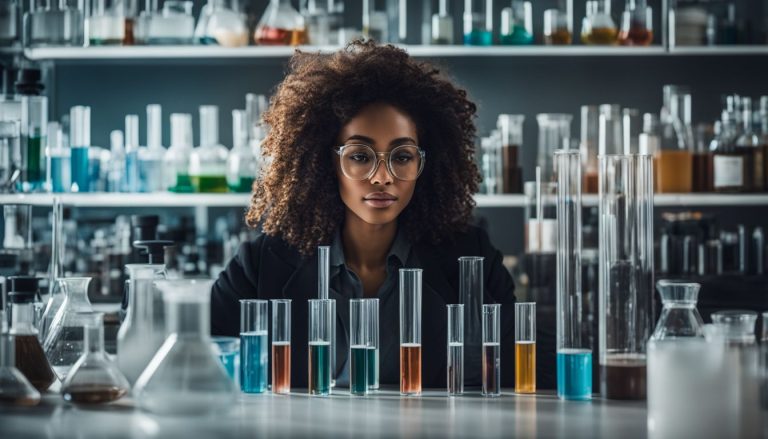The Role of Pheromone Androstenone in Human Attraction and Mood Regulation
Have you ever wondered why certain people seem to draw others in like magnets? Scientists have discovered that androstenone, a pheromone found in human sweat, plays a significant role in attraction.
In this blog post, we’ll dive into how this fascinating chemical can influence our mood and possibly tip the scales of romance in your favor. Keep reading to unlock the secrets of attraction hidden within us all.
Key Takeaways
- Androstenone, found in human sweat, is a powerful pheromone that can sway how attractive we find someone and influence our overall mood. Our bodies pick up these chemical signals through the nose, sparking reactions deep within our brains without us even knowing it.
- People produce and release different amounts of androstenone based on genetics, hormones, and what they eat. Red meat can increase its levels. This variation means everyone gives off their own unique scent signal that can affect others around them.
- The presence of androstenone has been seen to raise positive feelings like arousal in women as well as encourage social interactions. It also primes various emotional responses to situations which shows just how much this single compound affects social behavior.
- Not only does androstenone play a part in who we’re drawn to romantically but it also shapes our senses – changing what smells we like or dislike over time depending on context or personal experiences.
- By affecting attraction ratings amongst potential mates and altering mood states such as anxiety or stress levels in both men and women, this pheromone illustrates its importance beyond just sparking romance but extending into shaping many facets of human interaction.
Understanding Pheromones and their Effects
Pheromones are chemical signals that play a crucial role in communication and behavior among animals, including humans. These pheromones can elicit various responses such as attraction, aggression, or mood regulation.
Definition and Role in Animals and Humans
Pheromones are chemical signals released by an individual that trigger a social response in members of the same species. Animals use these powerful tools to communicate a range of messages from marking territory to signaling danger.
In the wild, these chemicals play an essential role in mating rituals by indicating readiness for reproduction or helping individuals identify each other.
Humans also have pheromones which affect mood regulation and attraction according to recent research on Androstenone effects. While human responses may be more subtle than those seen in animals, studies show that compounds like androstadienone increase attractiveness ratings and can even shift emotional states.
This indicates that our own olfactory system responds to these hidden scents influencing our interpersonal interactions. Realizing this opens up fascinating questions on how we unconsciously perceive others, leading us next into exploring how we detect pheromones around us.
Detection of Pheromones
Pheromones are detected by olfactory receptors in the nose. These receptors send signals to the brain’s limbic system, which is involved in emotion and memory. Once detected, pheromones can influence behavior, mood, and attraction at a subconscious level.
Androstenone and androstadienone are two pheromones that play a significant role in human attraction and mood regulation. Research suggests that exposure to these pheromones can impact attractiveness ratings of potential mates in both males and females.
The detection of pheromones occurs through specialized olfactory receptors sensitive to these chemical signals. This process triggers physiological and emotional responses without conscious awareness, influencing social behavior, mood enhancement, and sexual attraction.
The Role of Androstenone in Human Attraction
Androstenone, a type of male pheromone, plays a significant role in human attraction. It is believed to influence sexual attraction and behavior in both men and women.
Sources of Androstenone in Humans
Androstenone in humans originates from the apocrine glands, found in areas such as the armpits and genital region. These glands are influenced by genetic factors and hormonal fluctuations, leading to varying levels of androstenone secretion among individuals.
Additionally, dietary choices can impact the production of androstenone in humans, with studies suggesting that red meat consumption may elevate its presence.
The next section will delve into the effect of androstenone on sexual attraction in humans.
Effect on Sexual Attraction
After identifying the sources of androstenone in humans, it is essential to understand its effect on sexual attraction. Exposure to androstenone has been found to exert a positive impact on sexual attraction, especially in women.
Research suggests that androstadienone, a derivative of androstenone, has been linked to increased attractiveness ratings of potential mates in women. Furthermore, human-produced androstadienone has been shown to influence emotional states and mood in a context-dependent manner.
These findings indicate that the presence of androstenone can indeed play a significant role in enhancing sexual attraction.
Moreover, preliminary evidence indicates that exposure to male sweat containing androstadienone can increase attraction levels in women towards men. This suggests that the pheromones present within sweat, including those derived from androstenone, have an influential effect on sexual attraction.
Impact of Androstenone on Female Mood and Behavior
Androstenone can have modulator effects on female mood and behavior, influencing their emotional state and social interactions. It can also act as a primer, affecting future responses to stimuli, and serve as a signaler of reproductive status in females.
Modulator Effects
Androstenone exerts a noticeable effect on women’s mood, cognition, and attraction levels. When exposed to androstenone, women have shown increased positive mood states and elevated feelings of arousal.
Additionally, studies indicate that androstenone can positively modulate female behavior by enhancing sociability and receptiveness to social interactions. In particular, the effects of androstenone on female mood regulation are believed to play a significant role in human chemosensory communication.
Furthermore, preliminary evidence suggests that exposure to male-produced pheromones like androstadienone promotes attractiveness ratings of potential mates among females. Researchers also found that these modulator effects can influence emotional responses in a context-dependent manner.
Primer Effects
Exposure to androstadienone in women has been found to have primer effects, affecting their attitudes, emotions, and physiological states. This component of male sweat can influence attractiveness ratings of potential mates and may impact mood in various contexts.
Similarly, androstenol has also been reported to impact participants’ mood and judgments of attractiveness when present.
Research suggests that exposure to certain pheromones like androstadienone can prime individuals for certain social or emotional responses. It’s evident that these primer effects play a significant role in how pheromones such as androstadienone influence human attraction and mood regulation.
Signaler Effects
Androstadienone and androstenone in women can have signaler effects by promoting attractiveness ratings of potential mates. These pheromones impact mood, cognition, and attraction, contributing to a positive effect on the individual’s overall well-being.
Research indicates that exposure to male sweat, specifically containing androstadienone, increases attraction, affects mood and cortisol levels, and activates the brain. Similarly, the claimed secreted male pheromone that attracts a woman is androstenone exerting a positive effect on her mood and cognition.
The significance of these signaler effects demonstrates the potential influence of human-produced pheromones in modulating both emotional states as well as social behaviors. This supports their role in shaping human interaction through subtle but impactful chemical communication.
Other Potential Functions of Androstenone
Androstenone may also play a role in influencing chemo-sensory preferences, creating chemo-sensory perception, and impacting social behavior beyond just sexual attraction. Its effects on mood regulation and behavior go beyond its role in sexual attraction.
Flexibility in Chemosensory Preferences
Human chemosensory preferences exhibit remarkable flexibility, as they can be influenced by various factors such as context, individual differences, and even cultural norms. Research indicates that exposure to different pheromones like androstadienone in women can promote attractiveness ratings of potential mates, showcasing the adaptability of these preferences based on specific chemical cues.
Androstenol has been reported to influence judgments of attractiveness and affect participants’ mood, highlighting the dynamic nature of chemosensory perceptions in human interactions.
These findings underscore the intricate interplay between chemical signals and human behavior, indicating a complex system where chemosensory preferences can be modulated by diverse environmental stimuli.
This suggests that understanding the malleability of chemosensory preferences is crucial for comprehending how pheromones impact human attraction and mood regulation.
Creation of Chemosensory Perception
Exploring the impact of androstenone and androstadienone on human attraction sheds light on the creation of chemosensory perception. These pheromones play a crucial role in shaping individuals’ olfactory preferences, influencing how they interpret scents to form social connections.
Research indicates that exposure to these pheromones can modulate mood, cognition, and attractiveness ratings in context-specific settings, contributing to the rich tapestry of chemosensory perception in humans.
Furthermore, studies suggest that these pheromones not only exert direct effects on individuals but also interact with environmental stimuli to mold their sensory perceptions. This dynamic interplay between human-produced pheromones and external factors contributes to the intricate creation of chemosensory perception, emphasizing the multifaceted nature of olfactory experiences in human interactions.
Influence on Social Behavior
Androstenone and androstadienone, as human pheromones, play a significant role in influencing social behavior. Exposure to these pheromones can impact mating preferences by promoting attractiveness ratings of potential mates.
Additionally, these pheromones have been found to affect mood, cognition, and physiological states in both men and women. Studies have shown that the presence of androstadienone in women can lead to increased attractiveness ratings for potential partners.
Furthermore, exposure to these pheromones may also influence judgments of attractiveness while affecting emotional and attitudinal states in a context-dependent manner.
Conclusion
In conclusion, the pheromone androstenone plays a significant role in human attraction and mood regulation. It influences sexual attraction and can impact female mood and behavior.
This pheromone has been found to have modulator, primer, and signaler effects on individuals. Moreover, it may also have other potential functions such as influencing social behavior and creating chemosensory perceptions.
The flexibility in chemosensory preferences further highlights its impact on human interactions.
FAQs
1. What is the pheromone androstenone and how does it affect human attraction?
Androstenone is a male pheromone that can influence female sexuality and attraction, creating a powerful scent connection between people.
2. Can you smell pheromones like androstenone, and do they change our mood?
Yes, humans can detect the scent of pheromones such as androstenone which may play a role in mood regulation and increase feelings of attraction.
3. Is there such thing as an androstenone pheromone perfume or spray?
Indeed, products like Androstenone pheromone perfume or spray are designed to boost this specific scent to potentially enhance male attractiveness.
4. What impact do female pheromones have on males regarding Androstenone?
Female responses to male-produced Androstenone can vary; some may feel more attracted due to its presence while others might not be affected at all.
5. Does everyone respond to Androstenone’s effects in the same way?
Not exactly! The effect of Pheromones like Androstenon differs from person-to-person based on individual scent perception and pheromonal concentration within the environment.









